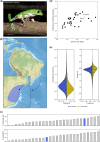Draft genome and multi-tissue transcriptome assemblies of the Neotropical leaf-frog Phyllomedusa bahiana
- PMID: 36205610
- PMCID: PMC9713437
- DOI: 10.1093/g3journal/jkac270
Draft genome and multi-tissue transcriptome assemblies of the Neotropical leaf-frog Phyllomedusa bahiana
Abstract
Amphibians are increasingly threatened worldwide, but the availability of genomic resources that could be crucial for implementing informed conservation practices lags well behind that for other vertebrate groups. Here, we describe draft de novo genome, mitogenome, and transcriptome assemblies for the Neotropical leaf-frog Phyllomedusa bahiana native to the Brazilian Atlantic Forest and Caatinga. We used a combination of PacBio long reads and Illumina sequencing to produce a 4.74-Gbp contig-level genome assembly, which has a contiguity comparable to other recent nonchromosome level assemblies. The assembled mitogenome comprises 16,239 bp and the gene content and arrangement are similar to other Neobratrachia. RNA-sequencing from 8 tissues resulted in a highly complete (86.3%) reference transcriptome. We further use whole-genome resequencing data from P. bahiana and from its sister species Phyllomedusa burmeisteri, to demonstrate how our assembly can be used as a backbone for population genomics studies within the P. burmeisteri species group. Our assemblies thus represent important additions to the catalog of genomic resources available from amphibians.
Keywords: Anura; Phyllomedusidae; amphibian; genome; mitogenome; transcriptome.
© The Author(s) 2022. Published by Oxford University Press on behalf of Genetics Society of America.
Figures

References
-
- Barth A, Souza VA, Solé M, Costa MA.. Molecular cytogenetics of nucleolar organizer regions in Phyllomedusa and Phasmahyla species (Hylidae, Phyllomedusinae): a cytotaxonomic contribution. Genet Mol Res. 2013;12(3):2400–2408. - PubMed
-
- Barth A, Vences M, Solé M, Costa MA.. Molecular cytogenetics and phylogenetic analysis of Brazilian leaf frog species of the genera Phyllomedusa and Phasmahyla (Hylidae: phyllomedusinae). Can J Zool. 2014;92(9):795–802.
-
- Batistic RF, Soma M, Beçak ML, Beçak W.. Further studies on polyploid amphibians: a diploid population of Phyllomedusa burmeisteri. J Hered. 1975;66(3):160–162.
-
- Bishop PJ, Angulo A, Lewis JP, Moore RD, Rabb GB, Moreno JG.. The Amphibian extinction crisis-what will it take to put the action into the Amphibian Conservation Action Plan? SAPIEN. 2012;5.2:97–111.
Publication types
MeSH terms
LinkOut - more resources
Full Text Sources
Research Materials
